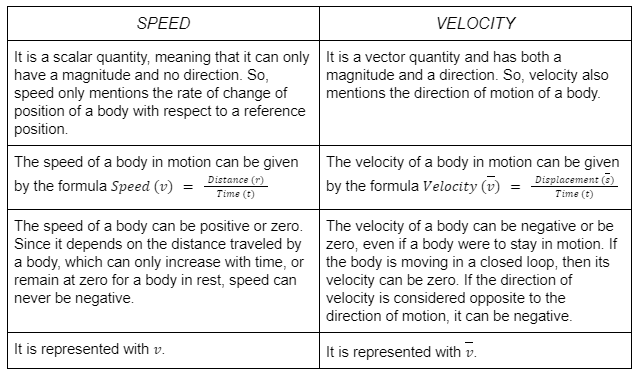When working with problems in classical mechanics, we often deal with the quantity called velocity. It is in fact one of the basic concepts of kinematics and often helps in a variety of calculations. On the other hand, the magnitude of velocity often referred to as speed, also plays an important part in many calculations where the direction of motion does not matter. Let us understand more about the concept of speed and velocity and how they differ from each other.
What is Velocity?
For a body in motion, the velocity of the body is the rate at which a body moves in a particular direction. Since velocity mentions the direction of motion along with the rate of movement of the body, it is a vector quantity. Its SI unit is meters per second or m/s. Velocity is given by the formula
For example, if we saw that Mr. Margo is moving with a velocity of 30m/s due north, this means that Mr. Margo has a speed of 30 m/s and the direction of his motion is towards the north.
What is Average Velocity?
The average velocity of a body is the ratio between the total displacement of a body and the time taken for the whole body to move from its initial position to its final position. Since displacement is a vector quantity, average velocity is a vector quantity too. Its SI unit is meters per second or m/s.
If a body covers x distance in t time, then its average velocity can be given by
v=xt
It must be noted that the average velocity of a body is always less than or equal to the speed of a body. This is because the displacement of a body, which determines its average velocity, can be equal to or less than its distance. Distance is always an increasing quantity.
What is Speed?
Speed refers to the rate at which a body in motion moves or operates. The speed of a body only has a magnitude and no direction, hence it is a scalar quantity. Its SI unit is meters per second or m/s.
Speed may also be defined as the absolute value or the magnitude of the velocity of a body and is given by the formula
Difference Between Speed and Velocity
Speed and velocity may seem to be the same thing to a person who is just starting out with concepts of kinematics. However, we must never forget that they are very different from each other and affect numerical problems and calculations differently. The main differences between speed and velocity are given in the table below.
Conclusion
Now that you have a brief understanding of the concepts of speed and velocity, you should be able to work with them easily. Practicing problems and sums with these concepts would be the best way to understand what they mean and how they affect different situations. Related problems in various online resources would be a great way to start solving related problems. You can also learn more about their significance in the field of kinematics to understand more.
 Profile
Profile Settings
Settings Refer your friends
Refer your friends Sign out
Sign out








